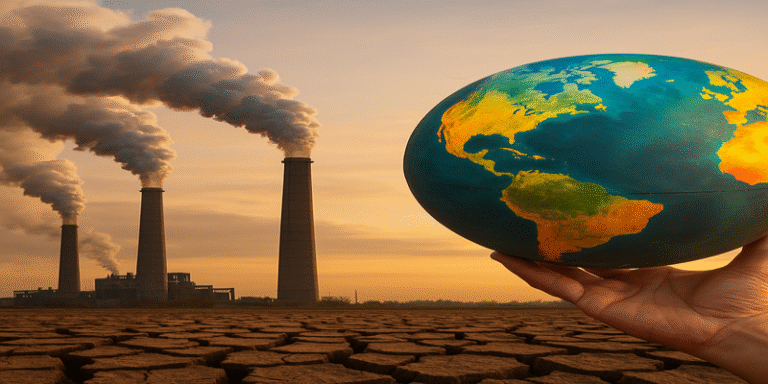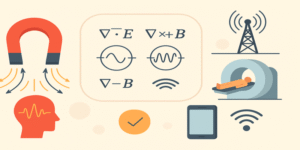One of the most significant challenges confronting humanity today is climate change, a phenomenon involving long-term alterations in global temperatures and weather patterns. While natural processes have historically contributed to climate variability, overwhelming evidence confirms that anthropogenic activities, particularly the combustion of fossil fuels, are the primary cause of global warming since the mid-20th century (IPCC, 2021).
Understanding the Science
At the core of climate change lies the greenhouse effect. The Earth’s atmosphere contains gases like carbon dioxide (CO₂), methane (CH₄), and nitrous oxide (N₂O), which trap heat from the sun, maintaining temperatures suitable for life. However, human activities—especially industrialisation, deforestation, and large-scale agriculture—have led to unprecedented concentrations of these greenhouse gases (GHGs) (EPA, 2022).
According to the Intergovernmental Panel on Climate Change (IPCC) Sixth Assessment Report, the global surface temperature has risen by approximately 1.1°C above pre-industrial levels, with projections of reaching 1.5°C between 2030 and 2052 if current trends persist (IPCC, 2021). This increase, though seemingly small, translates into dramatic shifts in climate systems and ecosystems worldwide.
Key Drivers of Climate Change
The main sources of GHGs are:
- Energy production, particularly from coal and oil (IEA, 2022)
- Transportation systems reliant on petrol and diesel
- Agricultural practices, including livestock and fertiliser use (FAO, 2021)
- Industrial emissions from cement and steel production
- Deforestation, which reduces the Earth’s carbon sequestration capacity
Land use changes and population growth further compound these effects. The World Resources Institute (2022) notes that deforestation alone contributes approximately 10% of global emissions.
Global Warming and Its Effects
The impact of climate change is multi-dimensional. Some of the most critical effects include:
1.0 Rising Sea Levels
Thermal expansion of seawater and melting glaciers are causing sea levels to rise, endangering coastal communities and low-lying island nations. The National Oceanic and Atmospheric Administration (NOAA) projects up to 2.1 metres of sea-level rise by 2100 under worst-case emissions scenarios (NOAA, 2021).
2.0 Extreme Weather Events
There is growing evidence linking climate change to increased frequency and intensity of hurricanes, floods, droughts, and wildfires. For instance, Europe’s 2022 heatwave was deemed “virtually impossible” without human-induced warming (World Weather Attribution, 2022).
3.0 Ocean Acidification
As oceans absorb more CO₂, their pH levels drop, threatening marine biodiversity, particularly coral reefs and shellfish populations (Doney et al., 2009). Acidification disrupts food chains, fishing industries, and carbon cycling processes.
4.0 Biodiversity Loss
Warming temperatures, altered rainfall patterns, and habitat destruction are accelerating the extinction rate of species. The IPBES (2019) reported that over 1 million species are at risk of extinction due to environmental pressures exacerbated by climate change.
Human and Societal Consequences
Climate change also has profound implications for human societies. These include:
- Food insecurity due to crop failures and declining yields (Lobell et al., 2011)
- Water scarcity in already arid regions
- Health risks from heatwaves, vector-borne diseases, and malnutrition (WHO, 2021)
- Economic losses, especially in agriculture, insurance, and real estate
- Climate migration, where populations are forced to relocate due to uninhabitable conditions
These challenges disproportionately affect developing countries, which contribute the least to global emissions yet bear the brunt of the impacts. This highlights the need for climate justice in international negotiations (UNFCCC, 2022).
Adaptation and Mitigation Strategies
In response, the global community is pursuing two primary pathways: mitigation and adaptation.
Mitigation
Mitigation involves reducing or preventing the emission of GHGs. Key strategies include:
- Transitioning to renewable energy sources (solar, wind, hydro)
- Enhancing energy efficiency in buildings and transport
- Carbon pricing mechanisms like cap-and-trade or carbon taxes
- Promoting sustainable agriculture and reforestation
The 2015 Paris Agreement, signed by 196 countries, aims to limit global warming to well below 2°C—preferably 1.5°C—above pre-industrial levels. Achieving this target requires net-zero emissions by mid-century (UNFCCC, 2015).
Adaptation
Adaptation refers to actions that help communities adjust to current or expected climate effects. This includes:
- Constructing flood defences and climate-resilient infrastructure
- Developing drought-resistant crops
- Improving early warning systems for natural disasters
- Strengthening health systems to cope with climate-induced diseases
Scholars such as Robinson et al. (2025) argue for integrated adaptation planning that considers both ecological and social systems, particularly in vulnerable coastal and marine areas.
The Role of Education and Behavioural Change
Public awareness and education are vital in driving behavioural changes that reduce carbon footprints. Environmental education fosters climate literacy, helping individuals understand their role in both contributing to and solving the problem.
From grassroots activism like Fridays for Future to policy debates, climate action is no longer the domain of scientists alone. Civic participation and local governance now play a crucial role in implementing climate solutions at the ground level (UNESCO, 2022).
Climate change and global warming are not distant threats—they are present-day realities with far-reaching consequences for ecosystems, economies, and human well-being. While the science is clear, solutions require political will, technological innovation, and global solidarity. Whether through mitigation, adaptation, or both, the time to act is now. A collective, equitable, and science-based approach is essential to preserve a habitable planet for current and future generations.
References
Doney, S.C., Fabry, V.J., Feely, R.A. and Kleypas, J.A. (2009). Ocean acidification: the other CO₂ problem. Annual Review of Marine Science, 1, pp.169–192.
EPA (2022). Sources of Greenhouse Gas Emissions. Environmental Protection Agency. Available at: https://www.epa.gov/ghgemissions.
FAO (2021). Climate change and food security. Food and Agriculture Organization. Available at: https://www.fao.org.
IEA (2022). World Energy Outlook 2022. International Energy Agency. Available at: https://www.iea.org/reports/world-energy-outlook-2022.
IPBES (2019). Global Assessment Report on Biodiversity and Ecosystem Services. Intergovernmental Science-Policy Platform.
IPCC (2021). Sixth Assessment Report. Intergovernmental Panel on Climate Change. Available at: https://www.ipcc.ch.
Lobell, D.B., Schlenker, W. and Costa-Roberts, J. (2011). Climate trends and global crop production since 1980. Science, 333(6042), pp.616-620.
NOAA (2021). Sea Level Rise Technical Report. National Oceanic and Atmospheric Administration. Available at: https://oceanservice.noaa.gov.
Robinson, C., Hobday, A.J., Murphy, E.J., et al. (2025). Integrated Marine Biosphere Research: Ocean Sustainability Under Global Change. Frontiers in Marine Science. Available at: https://www.frontiersin.org/articles/10.3389/fmars.2025.1684348.
UNFCCC (2015). The Paris Agreement. United Nations Framework Convention on Climate Change. Available at: https://unfccc.int/process-and-meetings/the-paris-agreement.
UNFCCC (2022). Climate Change: Impacts, Vulnerabilities and Adaptation. Available at: https://unfccc.int.
UNESCO (2022). Education for Sustainable Development. Available at: https://en.unesco.org/themes/education-sustainable-development.
WHO (2021). Climate change and health. World Health Organization. Available at: https://www.who.int/news-room/fact-sheets/detail/climate-change-and-health.









